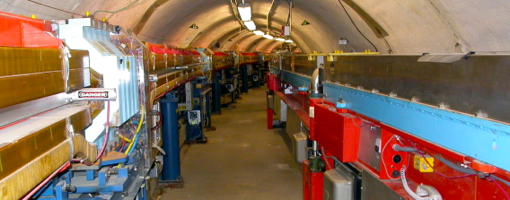Physics 4456/7656: Introduction to Accelerator Physics and Technology

View looking down the Cornell Electron Storage Ring (CESR) Tunnel.
Particle accelerators are some of the most complex instruments used for science. They are used for high energy physics, nuclear physics, x-ray science, in spectrometers, electron microscopes, and radiation therapy. These instruments have become so complex that an empirical approach to properties of the particle beams is by no means sufficient and a detailed theoretical understanding is necessary. This course introduces into theoretical aspects of charged particle beams and into the technology used for their acceleration.
Syllabus
- A short history and principles of particle accelerators
- Charged particles in electromagnetic fields
- Linear beam optics
- Linear beam optics in circular accelerators
- RF systems for particle acceleration
- Synchrotron radiation and radiative damping effects
Suggested Literature
- The Physics of Particle Accelerators, Klaus Wille, Oxford University Press, 2001, ISBN: 0198505493
- Particle Accelerator Physics, Helmut Wiedemann, Springer, 3nd edition, 2007, ISBN 3540490434
- Handbook of Accelerator Physics and Engineering, Alexander Wu Chao and Maury Tigner, 2nd edition, World Scientific, ISBN: 9810238584
Lecture Notes
I do allow my lectures notes, syllabi, and other course materials to be freely shared and distributed under a Creative Commons Attribution-NonCommercial-ShareAlike license; please see below for details.
- Lecture 1: Introduction; electrostatic accelerators, the betatron
- Lecture 2: RF accelerators
- Lecture 3: Particle Sources, injection, HEP, synchrotron light sources
- Lecture 4: Magnets
- Lecture 5: Multipole expansion, s.c. magnets
- Lecture 6: Equation of motion
- Lecture 7: Dispersion, focusing, achromat
- Lecture 8: Isochronous systems, transformation matrices
- Lecture 9: Thin lens, momentum compaction, twiss parameters
- Lecture 10: Phase space ellipse, emittance
- Lecture 11: Beam envelope, propagation of Twiss parameters
- Lecture 12: Periodic magnet sections, stability, tune
- Lecture 13: FODO, closed orbit
- Lecture 14: closed dispersion, dipole kicks, bumps
- Lecture 15: quadrupole errors, chromaticity
- Lecture 16: chromaticity correction, dynamic aperture, resonances
- Lecture 17: optical resonances
- Lecture 18: Waveguides
- Lecture 19: RF cavities: standing and traveling wave
- Lecture 20: RF cavities: circuit model, pillbox, HOMs
- Lecture 21: HOM damping, RF superconductivity, RF power sources
- Lecture 22: Synchrotron oscillations
- Lecture 23: Synchrotron oscillations, part 2
- Lecture 24: Synchrotron radiation
- Lecture 25: Damping effects
Creative Commons License
Attribution-NonCommercial-ShareAlike 3.0 United States
You are free:
- to Share: to copy, distribute, display my lecture notes and course materials
- to Remix: to make derivative works
Under the following conditions:
- Attribution: You must attribute the work in the manner specified by the author or licensor (but not in any way that suggests that they endorse you or your use of the work).
- Noncommercial: You may not use this work for commercial purposes Share Alike. If you alter, transform, or build upon this work, you may distribute the resulting work only under the same or similar license to this one.
For any reuse or distribution, you must make clear to others the license terms of this work. The best way to do this is with a link to this web page. Any of the above conditions can be waived if you get permission from the copyright holder. Apart from the remix rights granted under this license, nothing in this license impairs or restricts the author's moral rights.
Your fair use and other rights are in no way affected by the above. This is a human-readable summary of the Legal Code (the full license ).

Using an electronic ink/ interactive pen display in lecture.
